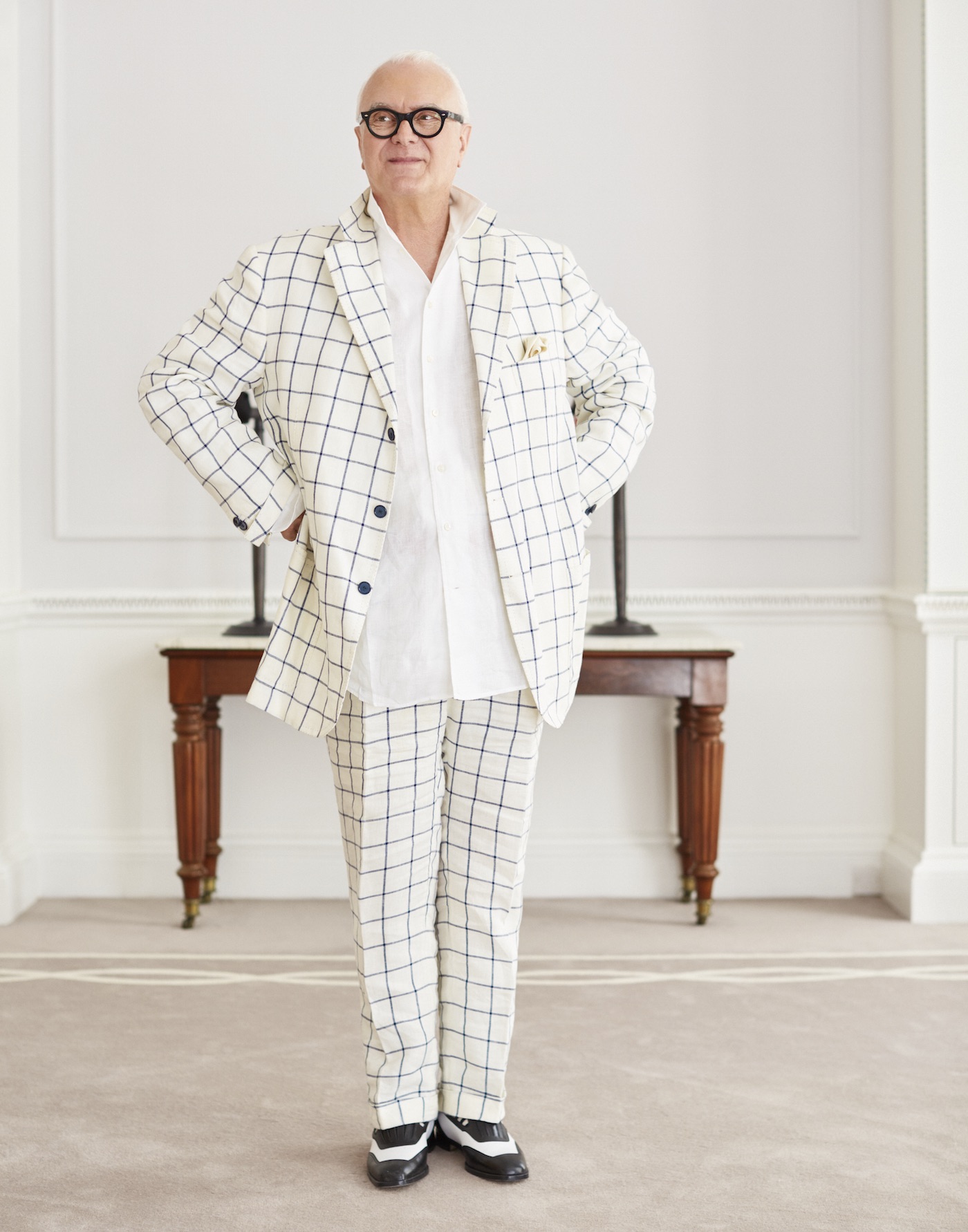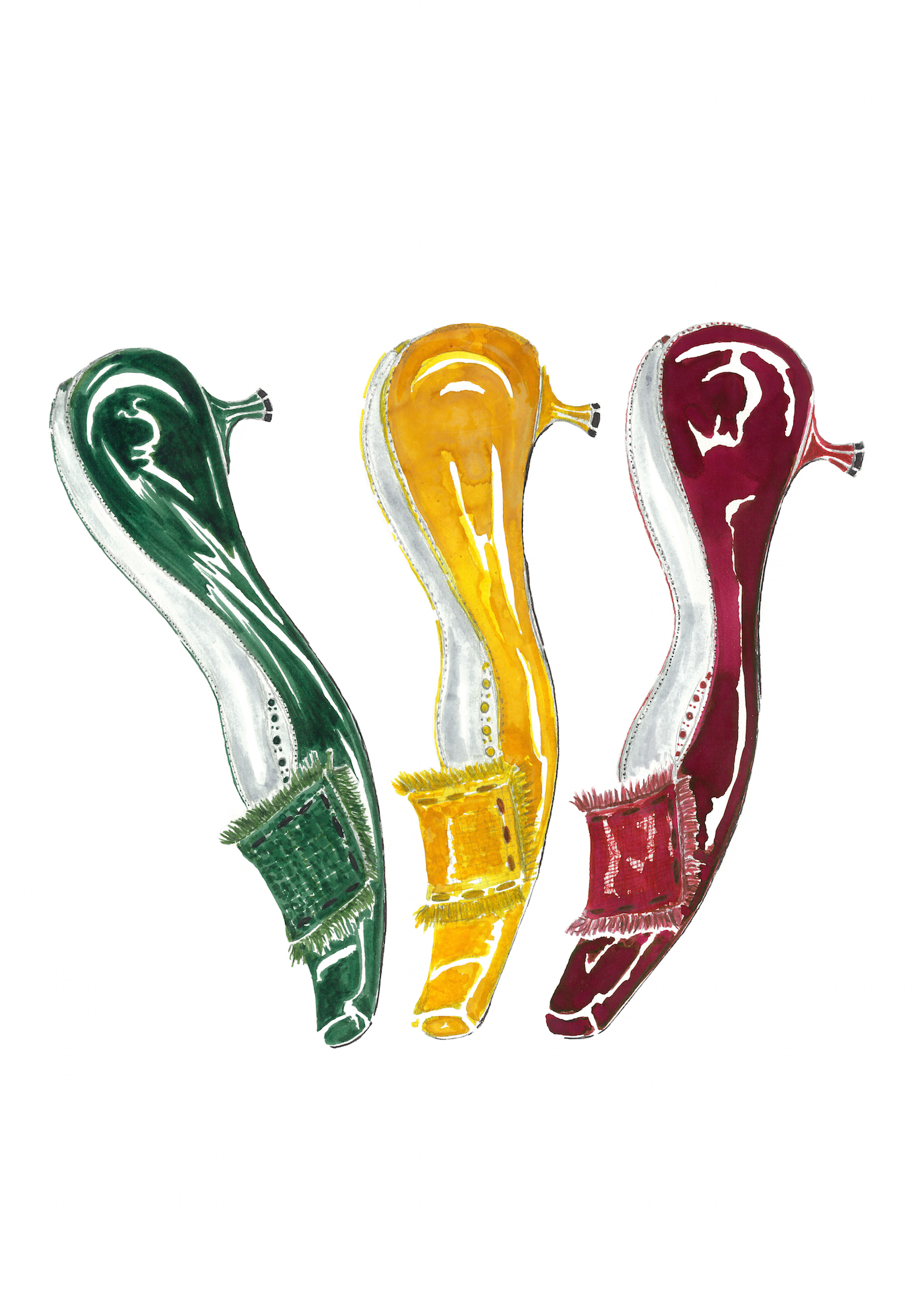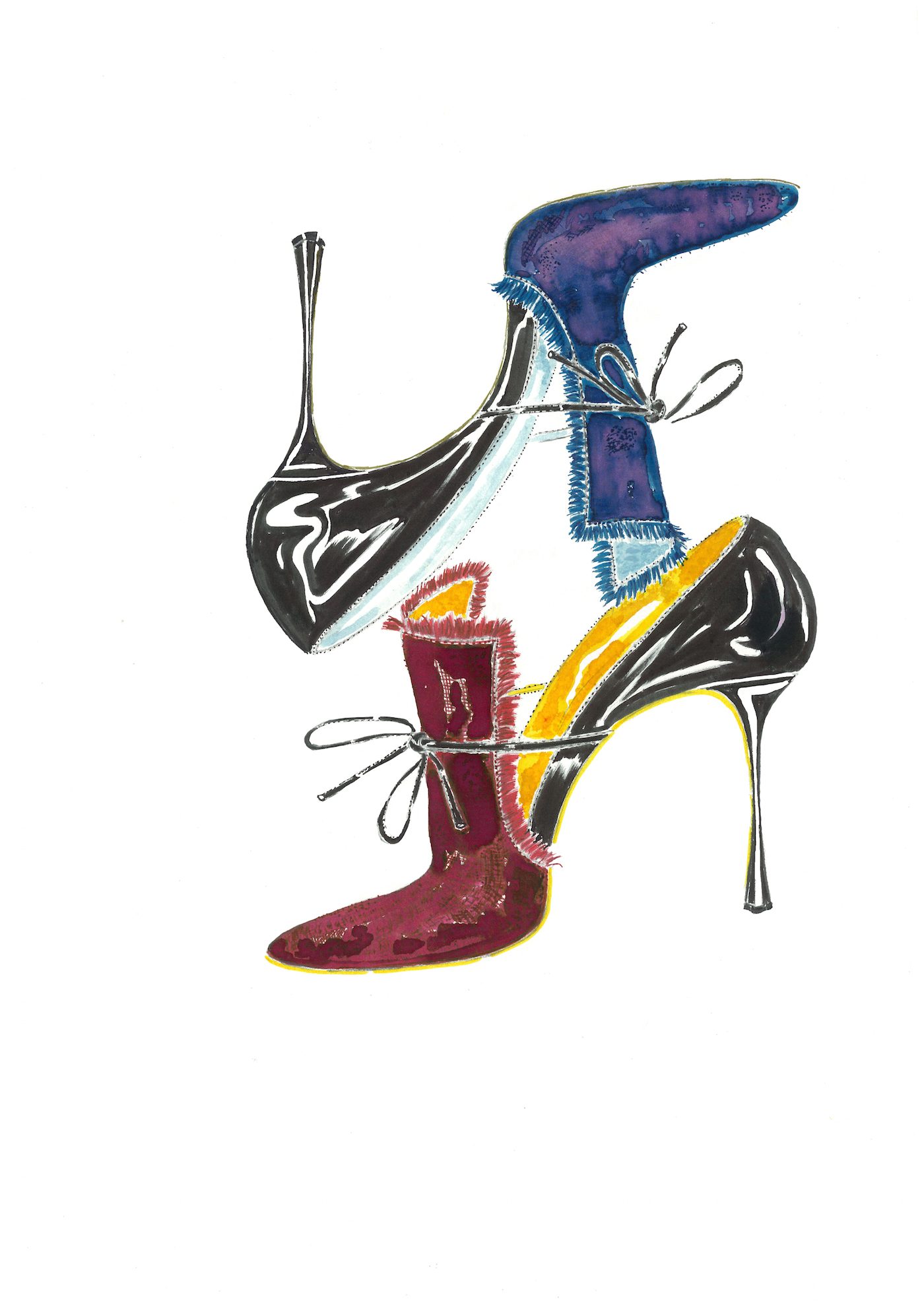In his shoes: the world according to Manolo Blahnik
Legendary shoe designer on what inspires him


Manolo Blahnik established his eponymous brand in 1972, just off London’s Kings Road; he remained in Chelsea for four decades before a short but significant move across Hyde Park to Marylebone in March 2015. The new address on Welbeck Street is his lifetime vision made concrete, harking back to the grandeur of old couture houses. A Georgian townhouse is now the heart of his privately owned business, which he runs with his sister Evangeline and her daughter Kristina, who was made CEO in 2009.
The interior design of Blahnik’s HQ is everything you would expect from the long-time arbiter of taste: unfussy and elegant with a gleaming black and white tiled floor, alabaster walls, and a sweeping staircase with plush pewter-grey carpet. Colour is provided by the shoemaker’s sketches, set in identical frames along the corridors. The drawings depict new designs as well as signature styles such as the Campy – a patent leather Mary-Jane with grosgrain detailing – and the Hangisi with its unmistakable square buckle set with Swarovski crystals. The sense of perfectionism is palpable; even the branded dove-grey stationery has seemingly been chosen to match the furnishings.
"Please! I don’t do things like that – they do it for me," Blahnik says jokingly when his maison’s attention to detail is commented upon. "I don’t even know what’s going on here, to tell you the truth. All we care about is shoes. And I did nice shoes for 2018."
The Week
Escape your echo chamber. Get the facts behind the news, plus analysis from multiple perspectives.

Sign up for The Week's Free Newsletters
From our morning news briefing to a weekly Good News Newsletter, get the best of The Week delivered directly to your inbox.
From our morning news briefing to a weekly Good News Newsletter, get the best of The Week delivered directly to your inbox.
Blahnik designs approximately 600 shoes per year, each one sketched by the master himself, using concentrated watercolours by respected artists’ suppliers Dr Ph. Martin’s. "I heard once that Adrian [Adolph Greenberg] used those inks," he says, referring to the influential American costume designer whose credits include 1939 movie classic The Wizard Of Oz. "My hands are always with gloves. Look at these hands! Full of it, everywhere. Ink, it doesn’t come out. You must do it with a pumice stone. You have to draw blood!"

Sitting across from Blahnik in the first-floor drawing room, which is lit by an antique crystal chandelier, I ask the designer if he can pinpoint some of his more recent influences. "You want to know about things like that?" he asks incredulously. "Do you have five days?" Ever the extrovert, Blahnik is at once warm, gregarious and eccentric: he rolls off anecdotes, historical facts and book recommendations with flair, jumping from topic to topic as if his words are perpetually playing catch-up with his imagination.
He eventually settles on 19th- century English designer Charles Frederick Worth, although only momentarily, since no influential artist is ever a solitary player in the mind of Manolo Blahnik.
The unprecedented success of the House of Worth, which saw patrons cross continents to be dressed by the historic couturier, led Blahnik to explore the life of the maison’s royal client Eugénie de Montijo – "She was a little girl from Granada in Spain, and now the Queen of France!" he says of the woman who married Napoleon III in 1853 – and delve further still into the annals of French history, literature and art. "People, if they want something, they want it," he muses. "They buy it if it’s good and incredible quality. That’s what Worth represented, in my eyes, at that time."
A free daily email with the biggest news stories of the day – and the best features from TheWeek.com
It is arguably this same commitment to quality and creativity that has secured Blahnik’s position at the summit of luxury shoemaking since the early ’70s. The veteran designer, who was made an honorary CBE in 2007, has been described as the "maestro of mules" and the maker of "limousine shoes". He has been named Accessory Designer of the Year three times by the British Fashion Council, and won its Outstanding Achievement Award in 2012. Other accolades include three CFDA Awards; trade journal Footwear News even named its Lifetime Achievement Award after the designer. 'Manolos' – as his creations are now best known – are sold worldwide, and the brand has 13 boutiques including a prime spot in London’s Burlington Arcade.
True to form, Blahnik has cast his net wide across a variety of artistic movements this autumn, referencing the heirloom jewels of Russia’s Catherine the Great as well as the mobiles of American sculptor Alexander Calder. In homage to the restrained style of Austrian architect and designer Josef Hoffmann, he has designed the Atada, a black leather pump with a sinuous wraparound ankle strap; the Pelosusfe, a flat sandal with a plumage of pastel- dyed ostrich and turkey feathers, is dedicated to the legendary singer Janis Joplin. Elsewhere in the collection, Blahnik looked to the rugged landscape of the Hebrides: images of windswept beaches give shape to suede pumps with scalloped edging, while signature designs are clad in fraying tweed.
Blahnik is himself no stranger to island life. He was born and raised in Santa Cruz de la Palma, the capital of the Canary
Island of La Palma, by his Czech father and Spanish mother, who ran a local banana plantation. "It was wonderful; idyllic in fact," he says, recalling the steep mountains, palm trees and pine forests of his childhood.
This year saw the premiere of the documentary Manolo: The Boy Who Made Shoes For Lizards, film director Michael Roberts’ intimate portrait of his life-long friend. The title may sound fanciful, but Blahnik did indeed fashion his very first footwear designs for unwittingly fashionable amphibians he would catch on the island as a child, their tiny feet lovingly wrapped in Cadbury’s chocolate wrappers.

Another childhood diversion came from fashion magazines, imported from South America: "It was an education. I grew up with the pages of Mrs Vreeland [Diana Vreeland, then editor of American Vogue]. Fashion magazines were my main fix, my food! I never stopped buying them; every cent I had I would spend on magazines." Later, he adds, "It was very lonely there, you know? There were no people."
At the behest of his father, Blahnik left the island to study politics and law in Geneva. "You know, the Swiss are fabulous, but sometimes I need expressive people," he explains. "And they do not express too much in Geneva." Paris was a much better fit, and in 1965 Blahnik enrolled at the École des Beaux-Arts, and then at the École du Louvre, where he studied set design.
Three years later, he arrived in London, where, he says, "I did not feel foreign for one second." During the day, Blahnik worked in the denim department of Feathers, a boutique run by Joan Burstein, later founder of Browns; at night, he would socialise with a fast set of friends that included fashion designer Ossie Clark. "There was freedom," he offers. "Nothing was about money. It was, 'I am going to do this wonderful dress.' No one said to Ossie, 'Who is going to buy it?' Everyone was doing things they loved, all the time."
Blahnik himself continued to draw, but his sketches were seen by few: "I had no time. I was rushing everywhere! This party, that party. I was busy, I was young, I was going crazy. This is the kind of London I love." One person who did take stock of his talent was Diana Vreeland, who, after seeing Blahnik’s sketches in 1970, implored him to "focus on extremities". To this day, Blahnik describes his career as "an accident, a really wonderful accident. I didn’t know whether I was any good at doing what I was going to do."
Blahnik’s devotion to his craft is as absolute today as it was back then. An artisan at heart, he continues to carve the first wooden last of every new model; he used to trial his shoes, too, but a fractured tendon put an end to this eccentric essayage. There are also his
collaborations with emerging brands and young superstars, including three collections – Denim Desserts, Savage and So Stoned – with singer Rihanna. Last year, he imagined wader-like satin boots and slingback pumps with babouche-style fold- down backs for the SS17 collection of Vetements, the label anchored in streetwear and fronted by brothers Demna and Guram Gvasalia.
Today, Blahnik is excited about his most recent collaboration. "I’m doing something with someone who is exquisite," he says, lowering his voice conspiratorially. "She’s called Grace Wales Bonner. She’s got it. The first collection I saw was out of this world!" For the Central Saint Martins graduate’s AW17 collection, Blahnik sketched patchworked leather boots with square toes; sandals are equally playful with black and white Dalmatian spots.
His references may jump from French empresses to unspoilt isles, but one constant in Blahnik’s output is his ability to surprise with designs that capture the zeitgeist. But just as he relishes new projects, he’s also protective of the past, even when it comes to his own designs.
Currently, the 74-year-old is gearing up for the next leg of his travelling exhibition, Manolo Blahnik: The Art Of Shoes, which presents more than 200 pairs sourced from his own beloved archive at his home in Bath. The exhibition, which debuted at Milan’s Palazzo Morando in January this year, has since travelled to the Hermitage Museum in St Petersburg and the Museum Kampa in Prague. “I have things everywhere!” exclaims Blahnik. "We are kind of reorganising. It’s hell. It exhausts me already thinking about it!"
With such a global following, it’s no wonder the designer has such a voracious appetite for international history and culture. He’s also rarely without a book; today, he recommends A Manual For Cleaning Women, a selection of autobiographical short stories by the late American writer Lucia Berlin. One of the chapters, Blahnik relates, vividly describes an old man "wearing these incredible big turquoise rings".
It’s an image that has clearly fired up that audacious imagination of Blahnik’s; a swirl of references doubtlessly vying for his attention. Where these thoughts will take him is anyone’s guess.
-
 Why is Trump’s alleged strike on Venezuela shrouded in so much secrecy?
Why is Trump’s alleged strike on Venezuela shrouded in so much secrecy?TODAY'S BIG QUESTION Trump’s comments have raised more questions than answers about what his administration is doing in the Southern Hemisphere
-
 Vance’s ‘next move will reveal whether the conservative movement can move past Trump’
Vance’s ‘next move will reveal whether the conservative movement can move past Trump’Instant Opinion Opinion, comment and editorials of the day
-
 Why recognizing Somaliland is so risky for Israel
Why recognizing Somaliland is so risky for IsraelTHE EXPLAINER By wading into one of North Africa’s most fraught political schisms, the Netanyahu government risks further international isolation